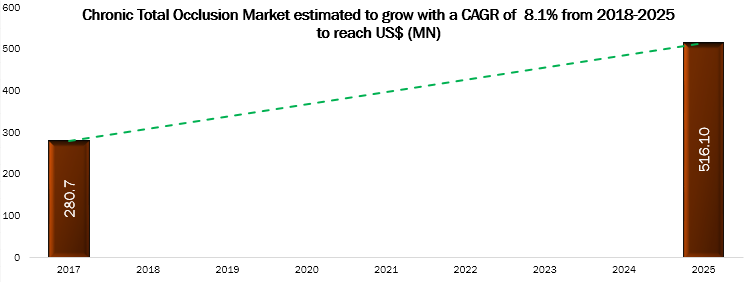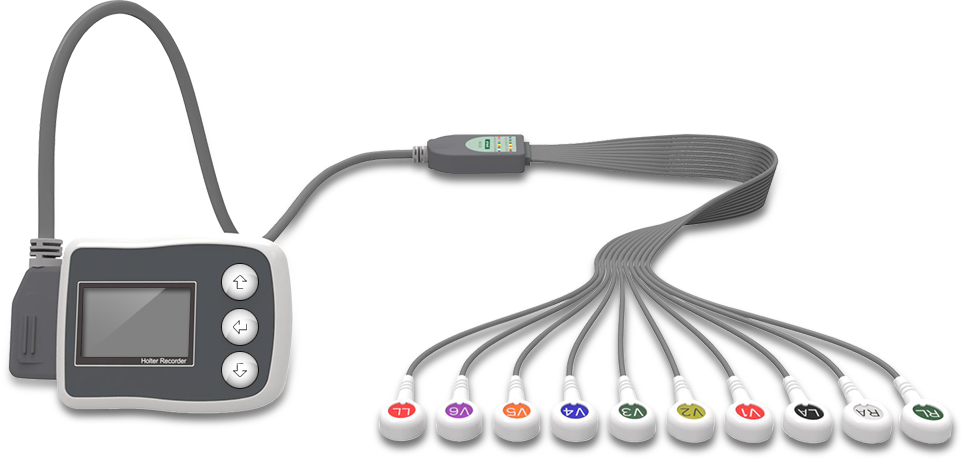Increasing Demand for Minimally Invasive Surgical Procedures is expected to enhance the Chronic Total Occlusion Market from 2018 to 2025.
The global chronic total occlusion market is expected to reach US$ 516.1 Mn in 2025 from US$ 280.7 Mn in 2017.
A minimally invasive medical procedure is generally carried out by entering the device in body through the skin or through a body cavity or anatomical opening, but with the smallest damage possible to these structures. Minimally invasive surgeries are being performed widely during the recent years. In the last few years, remarkable development has been made in the field of cardiovascular disease treatment. However, these complex medical procedures require a combination of rich experience and technical skills. Chronic total occlusion percutaneous coronary intervention is a minimally invasive technique for people with chronic total occlusion (CTO). With CTO, one or both of the coronary arteries becomes completely blocked. Patients suffering from CTO, percutaneous coronary intervention (PCI), which is a minimally invasive procedure for the reduction or elimination of the blockages. In a PCI, a non-surgical procedure, a catheter is used to place a stent to open up blood vessels in the heart. During the procedure, the physician, through a small incision near the patient’s groin or wrist, uses tiny specialty wires and other minimally invasive devices, to approach the CTO blockage(s) of the heart. The procedure is not like the typical PCI, which includes passing the wire through a narrow opening in the artery, CTO treatment generally involves guiding these specialty wires and devices through the blockage within the artery wall. In some patients, the degree of invasiveness of a surgical procedure can be reduced through a combination of procedures that are performed one after the other, such as the minimally-invasive, catheter-based implantation of an endovascular stent (PTCA), which is followed by heart valve replacement or repair by a cardiac surgeon. Minimally invasive surgery (MIS) has the advantages which include less tissue injury, reduced pain, faster oral intake, smaller hospitalization and better cosmetic appearance when compared with open surgery. The benefits as well as the accuracy being offered by minimally invasive surgeries are expected to drive the chronic total occlusion market.
Complications of PCI such as contrast induced renal dysfunction, radiation, etc., assume more relevance given the length and complexity of these procedures. Furthermore, complications such as donor vessel injury, foreign body entrapment are related exclusively to CTO PCI. Catheter induced injury can occur especially during equipment withdrawal or at the time of externalization of a snared wire, they cause the guide to deeply engage the vessel, and potentially lead to a guide induced dissection. Radiation injury is a complication of any PCI. CTO PCI, typically due to longer time involved, is one of the predictors of increased radiation dose. Hence, chronic total occlusion devices have high risks of severe effects in patients, therefore the chronic total occlusion market get hampered to some extent in the forecasted period.
The major players operating in the chronic total occlusion market include ASAHI INTECC CO., LTD, SoundBite Medical Solutions, Integer Holdings Corporation, Baylis Medical Company, Inc, SPECTRANETICS, C. R. Bard, Inc., Boston Scientific Corporation, Medtronic, Terumo Corporation, Cordis, and Abbott.



